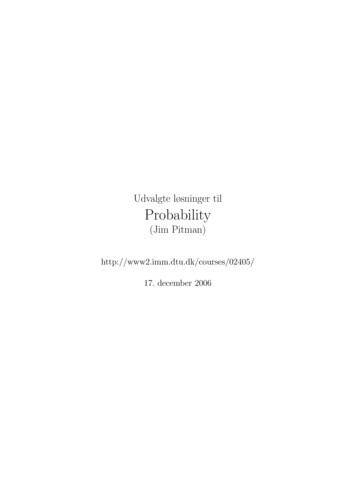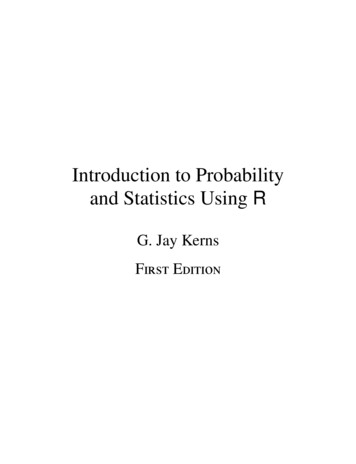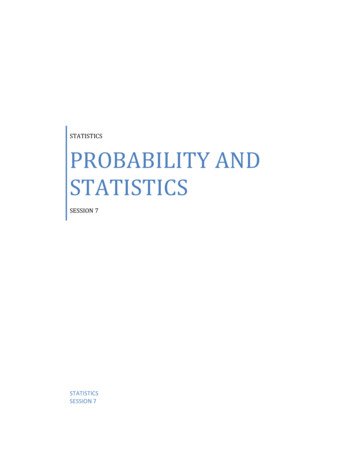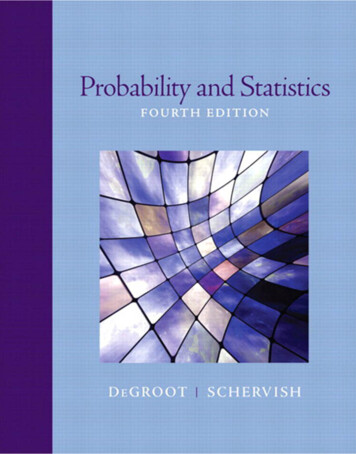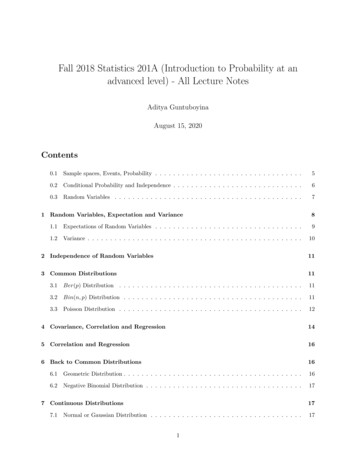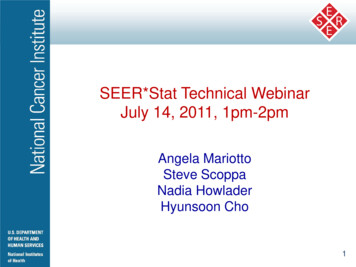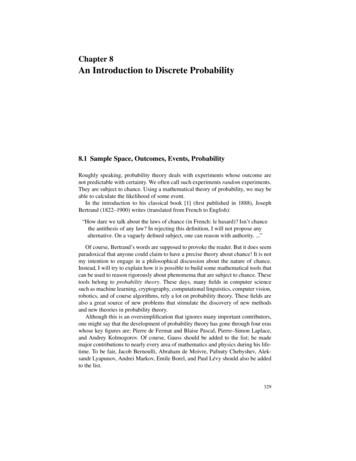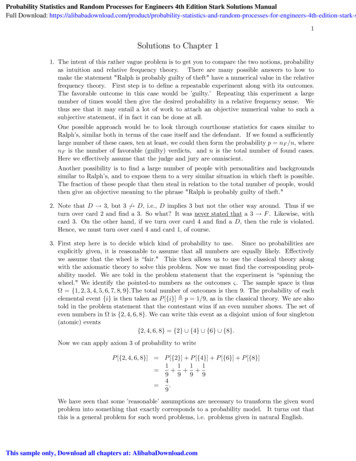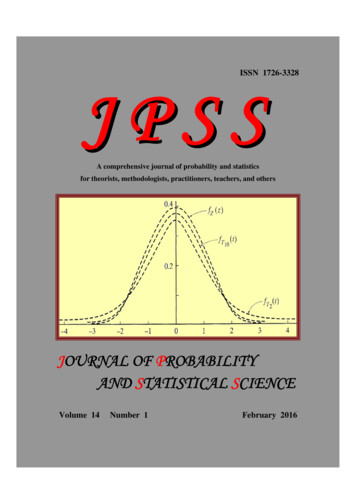
Transcription
ISSN 1726-3328JPSSA comprehensive journal of probability and statisticsfor theorists, methodologists, practitioners, teachers, and othersJOURNAL OF PROBABILITYAND STATISTICAL SCIENCEVolume 14Number 1February 2016
ISSN 1726-3328JPSSJournal of Probability and Statistical ScienceA Comprehensive Journal of Probability and Statisticsfor Theorists, Methodologists, Practitioners, Teachers, and OthersEditor-in-Chief: B. M. Golam KibriaVolume 14 Number 1February 2016Published by: Susan Rivers’ Cultural Institute, Hsinchu City, Taiwan, ROC.
JPSS Editorial BoardEditor-in-Chief: (since January 1, 2016)B. M. Golam Kibria, Dept. of Math. & Statistics, Florida International Univ., Miami, FL 33199, USA;e-mail: kibriag@fiu.edu. (speciality: statistical inference, regression analysis, applied statistics)Editors: (listed in alphabetical order according to last name)Paul C. Chiou, Dept. of Math., Lamar Univ., Beaumont, TX 77710, USA; e-mail: chiou@math.lamar.edu.Chien-Pai Han, Dept. of Math., Univ. of Texas at Arlington, Arlington, TX 76019, USA.e-mail: cphan@uta.edu. (speciality: statistical inference, multivariate analysis, sampling theory)Coordinating Editors:Syed A. Hossain, Management Science Dept., Rider Univ., Lawrenceville, NJ 08648, USA.e-mail: shossain@rider.edu. (speciality: Financial math., Mathematical statistics, Software reliability)Borko D. Jovanovic, Dept. of Preventive Medicine, Northwestern Univ., Chicago, IL 60611, USA.e-mail: borko@northwestern.edu. (speciality: biomedical statistics and epidemiology)Chihwa Kao, Center for Policy Research, Syracuse Univ., Syracuse, NY 13244, USA.e-mail: cdkao@maxwell.syr.edu. (speciality: statistics for economics and business)Andrzej Korzeniowski, Dept. of Math., Univ. of Texas at Arlington, Arlington, TX 76019, USA.e-mail: korzeniowski@uta.edu. (speciality: probability theory and its applications)K. Muralidharan, Dept. of Statistics, M. S. Univ. of Baroda, Baroda-390002, India.e-mail: lmv murali@yahoo.com. (speciality: applied probability and statistics for industry)Kamel Rekab, Dept. of Math. & Statistics, Univ. of Missouri, Kansas City, MO 64110-2499, USA.e-mail: rekabk@umkc.edu. (speciality: statistical software testing and reliability, network security,biostatistics, statistics in advanced manufacturing & quality improvement, sequential analysis, etc.)Mohammad Salehi M., Dept. of Math., Statistics, and Physics, Qatar Univ., P.O. Box 2713, Doha, Qatar.e-mail: salehi@qa.edu.qa. (speciality: sampling theory and survey methodology)Editorial Advisors:Barry C. Arnold, Dept. of Statistics, U. of California, Riverside, CA 92521-0002, USA.N. Balakrishnan, Dept. of Math. & Statistics, McMaster U., Hamilton, Ontario, Canada L8S 4K1.Alexander Basilevsky, Dept. of Math. & Statistics, U. of Winnipeg, Winnipeg, Manitoba, Canada R3B 2E9.James E. Gentle, Dept. of Comput. Science & Informatics, George Mason U., Fairfax, VA 22030, USA.Arjun K. Gupta, Dept. of Math. & Statistics, Bowling Green State U., Bowling Green, Ohio 43403, USA.André I. Khuri, Dept. of Statistics, U. of Florida, Gainesville, FL 32611-8545, USA.Kiang Liu, Dept. of Preventive Medicine, Northwestern U., Chicago, IL 60611, USA.Shaw-Hwa Lo, Dept. of Statistics, Columbia U., New York, NY10027, USA.Kung-Jong Lui, Dept. of Math. & Statistics, San Diego State U., San Diego, CA 92182-7720, USA.Douglas C. Montgomery, Dept. of Industrial Engineering, Arizona State U., Tempe, AZ 85287, USA.Serge B. Provost, Dept. of Statist. & Actuarial Sci., U. of W. Ontario, London, Ontario, Canada N6A 5B7.Sheldon M. Ross, Dept. of Ind. Sys. Eng., U. of Southern California, Los Angeles, CA 90089, USA.A. K. Md. Ehsanes Saleh, School of Math. & Statistics, Carleton U., Ottawa, Ontario, Canada K1S 5B6.Robert J. Serfling, Dept. of Mathematical Sciences, U. of Texas at Dallas, Richardson, Texas 75083, USA.Ahmad Reza Soltani, Dept. of Statistics and Operational Research, Kuwait U., Safat 13060, Kuwait.Lee-Jen Wei, Dept. of Biostatistics, Harvard U., Boston, MA 02115, USA.Production Editor:Chih-Chiang Cheng, Dept. of Electrical Engineering, National Sun Yat-Sen U., Kaohsiung, Taiwan, ROC.Marketing Manager: Ardor Yu-Hong Chen (CEO of Techcom Information Corp., Taipei), Center ofSampling Survey, Oriental Institute of Tech- nology, Ban-Chiao, New Taipei City, Taiwan, ROC;e-mail: techcom5054@hotmail.com.Managing (and Founding) Editor: Kuang-Chao Chang, Dept. of Statistics and Information Science,Fu Jen Catholic Univ., Taipei, Taiwan, ROC; e-mail: stat1016@mail.fju.edu.tw.
JPSS Editorial Board(continued)Associate Editors:Essam K. AL-Hussaini, Dept. of Statistics & O. R., Kuwait U., Safat 13060, Kuwait.K. K. Achary, Dept. of Statistics, Mangalore U., Mangalagangothri-574199, India.Ahmed N. Albatineh, Dept. of Community Med. and Behavioral Sci., Kuwait Univ., Safat 13110, Kuwait.Gokarna Aryal, Dept. of Math., CS & Statistics, Purdue U., Hammond, IN 46323, USA.Olivier Basdevant, The World Bank, Washington DC 20433, USA.John J. Borkowski, Dept. of Mathematical Sciences, Montana State U., Bozeman, Montana 59717, USA.Connie M. Borror, Division of Management Information, U. of Illinois, Champaign, IL 61820, USAElvan Ceyhan, Dept. of Math., Koc U., Sariyer, Istanbul, Turkey.Chang-Tai Chao, Dept. of Statistics, National Cheng-Kung U., Tainan, Taiwan, ROC.Ajit Chaturvedi, Dept. of Statistics, U. of Delhi, Delhi 110 007, India.Jie Chen, Dept. of Biostatistics & Epidemiology, Georgia Regents Univ., Augusta, GA 30912-4900, USA.Tzu-chin R. Chou, Dept. of Applied Statistics and Information Sci., Ming Chuan U., Taoyuan, Taiwan, ROC.Po-Huang Chyou, Marshfield Medical Research Foundation, Marshfield, WI 54449, USA.David Drain, Dept. of Math. & Statistics, U. of Missouri-Rolla, Rolla, MO 65409-0020, USA.Jamie Emerson, Perdue School of Business, Salisbury U., Salisbury, MD 21801, USA.Florence George, Dept. of Math. and Statistics, Florida International Univ., Miami, Florida 33199, USA.Jan Hannig, Dept. of Statistics and O. R., U. of North Carolina at Chapel Hill, Chapel Hill, NC 27599, USA.Chia-Ding Hou, Dept. of Statistics and Information Sci., Fu Jen Catholic U., Taipei, Taiwan, ROC.Hsiao-Yun Huang, Dept. of Statistics and Information Sci., Fu Jen Catholic U., Taipei, Taiwan, ROC.Yu-Sheng Hsu, Dept. of Math., National Central U., Chung-Li, Taiwan, ROC.Anwar H. Joarder, School of Business, U. of Liberals Arts Bangladesh, Dhanmondi, Dhaka 1209, Bangladesh.Shahjahan Khan, Dept. of Math. & Computing, U. of S. Queensland, Toowoomba, Qld. 4350, Australia.Tai-Ming Lee, Dept. of Statistics and Information Sci., Fu Jen Catholic U., Taipei, Taiwan, ROC.Pen-Hwang Liau, Dept. of Mathematics, National Kaohsiung Normal U., Kaohsiung, Taiwan, ROC.Shang P. Lin, Dept. of Health Studies (Biostatistics Lab), U. of Chicago, Chicago, IL 60637, USAHung-Yi Lu, Dept. of Statistics & Information Science, Fu Jen Catholic U., Taipei, Taiwan, ROC.Suzanne McCoskey, Dept. of Economics, United States Naval Academy, Annapolis, MD 21402, USA.Vincent F. Melfi, Dept. of Statistics and Probability, Michigan State U., East Lansing, MI 48824, USA.Weiwen Miao, Dept. of Math. & Statistics, Haverford College, Haverford, PA 19041, USA.Magdi S. Moustafa, Dept. of Math., The American U. in Cairo, Cairo 11511, Egypt.Hassen A. Muttlak, Dept .of Math. Sci, King Fahd U. of Petroleum and Minerals, Dhahran, Saudi Arabia.B. N. Pandey, Dept. of Statistics, Banaras Hindu U., Varanasi 221005, India.M. N. Patel, Dept. of Statistics, School of Sciences, Gujarat U., Ahmedabad-380009, India.Mohammad Z. Raqab, Dept. of Mathematics, U. of Jordan, Amman 11942, Jordan.Kevin Robinson, Dept. of Math., Millersville U., PA 17551-0302, USA.Amitava Saha, Directorate General of Mines Safety, Dhanbad, Jharkhand-826001, India.Henri Schurz, Dept. of Mathematics, Southern Illinois U., Carbondale IL 62901-4408, USA.John F. Shortle, Dept. of Systems Engineering and O. R., George Mason U., Fairfax, VA 22030, USA.Lotfi Tadj, Dept. of Statistics and O. R., King Saud U., Riyadh 11451, Saudi Arabia.Fred Torcaso, Dept. of Mathematical Sciences, The Johns Hopkins U., Baltimore, MD 21218, USA.Wensong Wu, Dept. of Math. & Statistics, Florida International Univ., Miami, FL 33199, USA.Liang Zeng, Dept. of Physics and Geology, U. of Texas Pan American, Edinburg, TX 78539, USA.Associate Managing Editor:Sy-Mien Chen, Dept. of Mathematics, Fu Jen Catholic U., Taipei, Taiwan, ROC.
機統學誌JPSSISSN 1726-3328Journal of Probability and Statistical SciencePublished by: Susan Rivers’ Cultural Institute, Hsinchu City, Taiwan, ROCAims and Scope The Journal of Probability and Statistical Science (JPSS, ISSN1726-3328) is a modified version of the Journal of Propagations in Probability andStatistics (JPPS, ISSN 1607-7083). JPSS, like its predecessor JPPS, is a multipurpose andcomprehensive journal of probability and statistics that publishes papers of interest to a broadaudience of theorists, methodologists, practitioners, teachers, and any other users ofprobability and/or statistics. The scope of JPSS is intended to be quite broad, including allthe major areas of probability and statistics. Research papers involving probability and/orstatistics, either theoretical or applied in nature, will be seriously considered for publication.Additionally, papers involving innovative techniques or methods in teaching probabilityand/or statistics will also be considered. Papers submitted for publication consideration willbe peer reviewed. Initially, we will publish semiannually, one issue each in February andAugust. Hopefully, as time accrues, we will be able to publish quarterly. It is the goal ofJPSS to publish a wide range of works involving probability and/or statistics (theoreticaland/or applied in nature) and provide widespread availability of such to a broad audience ofpeople interested in probability, statistics and biostatistics.Submission and Review Policies1. Submission of manuscript written in English should be mailed (by email attachment) tothe Editor-in-Chief, an Editor, a Coordinating Editor, or to the Managing Editor atthe address provided in the JPSS Editorial Board.2. A manuscript is accepted only with the understanding that the text has not appeared inpublication, and that it is not being simultaneously reviewed by any other journal.3. Submitted manuscripts are refereed by a double-blind process, meaning that the reviewerswill not know the names of the authors and vice versa.4. If an article is accepted for publication, the author(s) will be required to provide anelectronic copy of the paper, in Micro-soft Word or PCTEX format, through an emailattachment. The authors will also be requested to transfer their copyright on certainconditions to the publisher.Publisher Harold C. H. Chen, Head, Susan Rivers’ Cultural Institute. Address: 26, Lane 2,Chien Mei Road, Hsinchu, Taiwan, ROC. Phone: (03)5716594, Fax: �司: 中華民國臺灣新竹市建美路 2 巷 26 號。版權所有,不得翻印!
February 1, 2016Announcing the New JPSS Editor-in-Chief !Susan Rivers’ Cultural Institute is pleased to announce the appointment of Dr. B. M. GolamKibria as the new Editor-in-Chief for JPSS, succeeding Dr. Paul C. Chiou of LamarUniversity. Dr. Kibria is a Professor in the Department of Mathematics & Statistics atFlorida International University, Miami, FL 33199, USA. He has published over 140research papers in professional journals including Journal of the American StatisticalAssociation, Journal of Multivariate Analysis, IEEE Transactions on Reliability, and such.Dr. Kibria is an elected member of International Statistical Institute (ISI) and an electedFellow of the Royal Statistical Society (FRSS). He is also involved in the editorial board ofmany international statistical journals, including Communications in Statistics.- Harold C. H. ChenHead, Susan Rivers’ Cultural InstituteHsinchu City, Taiwan, ROC- Kuang-Chao Chang, Managing and Founding Editor of JPSSProfessor, Department of Statistics & Information Science, Fu Jen Catholic UniversityNew Taipei City, Taiwan, ROC“ I am pleased to have Dr. B. M. Golam Kibria succeed me as the new Editor-in-Chief ofJPSS. Golam possesses outstanding academic and professional credentials that makehim well qualified to assume the role of Editor-in-Chief, and I believe he will continue toexpand the impact of JPSS as he continues the journal’s tradition of providing exceptionalvalue to the broad audience of theorists, methodologists, practitioners, teachers, and anyother users of probability and/or statistics. ”- Paul C. Chiou, JPSS Editor-in-Chief (2003-2015)Professor, Department of Mathematics, Lamar UniversityBeaumont, TX 77710, USA
ISSN 1726-3328JPSSJournal of Probability and Statistical ScienceVolume 14Number 1February 2016Table of ContentsTheory and MethodsFunctional Local Linear Regression Model with Functional --------------------------------------- Naceri AminaExtensions of Matrix Multivariate T-distribution---------------------------------- José A. Díaz-García and Ramón Gutiérrez-SánchezLog-Esscher Transformed Laplace Distribution and Its Applications------------------------------------- Sebastian George, Dais George, and Ligi GeorgeTerminal-dependent Estimation for FBSDE with Partial Linear ---------------------- Yuxia Su and Yutian Wang45Likelihood Transformation and Information Based Approach to -------- Milan Bimali and Michael Brimacombe5711329Teaching and ApplicationsAn Application of Fisher’s Exact Test in Linguistic Research-------------------------- One-Soon Her, Rwei-ju Chuang, and Kuang-Chao ChangA Simulation Study on Statistical Analysis of Pooled Samples in Periodontal Research– A Preliminary Report ---------------- K. M. Chang, Y. H. Lee, and K. C. ChangAn Old Example of Coupon Collecting Problem ------------------- Kuang-Chao ChangAppendixPublished by: Susan Rivers’ Cultural Institute, Hsinchu City, Taiwan, ROC.758195
Journal of Probabilityand Statistical Science14(1), 1-11, Feb. 2016Functional Local Linear Regression Modelwith Functional ResponseNaceri AminaLaboratoire de Statistique et Processus Stochastique, Univ. Djillali LiabèsABSTRACT In this paper, we introduce a new nonparametric estimation of theregression function when both the response variable and the explanatory one arefunctional. Our estimate is based on local polynomial approach. As asymptotic results,we state the rates of the uniform almost complete convergence of this estimate. The latterexpressed as function of the small ball probability of the predictor and as function of theentropy of the set on which the uniformity is obtained.Keywords Functional data; Kernel method; Local linear estimate; Functional response;Almost complete convergence.1. IntroductionThe functional statistics area has received an increasing interest in recent years. Thisgreat consideration is due to the interaction with other applied fields. Typically, this areaconcerns the modelization of variables taking values in infinite dimensional spaces, whichappear in applied sciences such as economics, soil science, epidemiology or environmetalscience, among others. Some key references on this topic are the monographs of Ramsay andSilverman [15], Bosq [3], Ferraty and Vieu [14]. In this context, regression model is main toolto explain how a variable of interest Y is linked with a regressor X. In this paper we considerthe problem of estimation of the regression function when both variables (response andexplanatory) are functional by using local linear method.It is well known that a local polynomial smoothing has various advantages over thekernel method, namely in the bias term moreover the kernel method, so-called local constantmethod, is known for being a particular case of the local polynomial method. We return to Fan Received November 2014, revised August 2015, in final form September 2015. Naceri Amina is affiliated with Laboratoire de Statistique et Processus Stochastique, Univ. DjillaliLiabès, BP 89 Sidi Bel Abbès 22000, Algeria; email: amina nrc@outlook.fr. 2016 Susan Rivers’ Cultural Institute, Hsinchu, Taiwan, Republic of China.ISSN 1726-3328
Journal of Probabilityand Statistical Science14(1), 13-28, Feb. 2016Extensions of Matrix Multivariate T-distributionJosé A. Díaz-GarcíaUniversidad Autónoma Agraria Antonio NarroRamón Gutiérrez-SánchezUniversity of GranadaABSTRACT Supposing Kotz-Riesz type I and II distributions and their correspondingindependent univariate Riesz distributions the associated generalised matrix multivariateT distributions, termed matrix multivariate T-Riesz distributions are obtained. In addition,its various properties are studied. All these results are obtained for real normed divisionalgebras.Keywords Matrix multivariate; T-distribution; Riesz distribution; Kotz-Riesz distribution; Real, complex, quaternion and octonion random matrices; Real normed divisionalgebras.1. IntroductionIn many statistical models, as an alternative to the use of matrix multivariate normaldistribution from the 80's it has been assumed a matrix multivariate elliptical distribution.Actually, the matrix multivariate elliptical distribution is a family of distributions thatincludes the matrix multivariate normal, contaminated normal, Pearson type II and VII, Kotz,Jensen-Logistic, power exponential and Bessel distributions, among others. These distributions have tails that are more or less weighted, and/or display a greater or smaller degree ofkurtosis than the normal distribution, refer to Fang and Zhang [12] and Gupta and Varga [16].In addition, matrix multivariate elliptical distributions are of great interest due to the nextinvariance property: Assume that X is distributed according to a matrix multivariate distribution, thenthe distributions of certain type of matrix transformations of the random matrix, say Y f (X), areinvariant under all class of matrix multivariate elliptical distribution, furthermore, such distributionscoincide when X is normally assumed, see Fang and Zhang [12] and Gupta and Varga [16].However, this invariance property is present when certain statistical (probabilistic) dependence is Received February 2014, revised October 2015, in final form December 2015. José A. Díaz-García (corresponding author) is affiliated with the Universidad Autónoma AgrariaAntonio Narro, Calzada Antonio Narro 1923, Col. Buenavista, 25315 Saltillo, Coahuila, México;email: jadiaz@uaaan.mx. Ramón Gutiérrez-Sánchez is affiliated with the Department of Statisticsand O.R, University of Granada, Granada 18071, Spain; email: ramongs@ugr.es. 2016 Susan Rivers’ Cultural Institute, Hsinchu, Taiwan, Republic of China.ISSN 1726-3328
Journal of Probabilityand Statistical Science14(1), 29-44, Feb. 2016Log-Esscher Transformed LaplaceDistribution and Its ApplicationsSebastian GeorgeSt. Thomas College, PalaDais GeorgeCatholicate CollegeLigi GeorgeSt. Thomas College, KozhencherryABSTRACT Esscher transformed Laplace distribution was first introduced by Georgeand George [3] in 2012. It is asymmetric, heavy-tailed and a tilted version of thestandard classical Laplace distribution. This distribution belongs to the one parameterexponential family and is suitable for modeling financial and file size data. It was feltthat a more realistic model would be a distribution such that the logarithm of the datafollows Esscher transformed Laplace distribution. Hence, a new distribution namely,log-Esscher transformed Laplace distribution which is also asymmetric, heavy-tailed andbelonging to the one parameter exponential family is introduced. Exponential familiesare of fundamental importance in probability theory and Statistics. Families of this typeare especially tractable for statistical inference. We derive the explicit form of its density,distribution function and quantile function. Various properties and characterizations ofthe distribution are studied and its parameter is estimated using different methods ofestimation. We also consider a real application of this distribution and establish that thisdistribution is a good fit.Keywords Esscher transformed Laplace distribution; Entropy; Financial modeling;Log-Esscher transformed Laplace distribution; Maximum likelihood estimator.1. IntroductionEsscher transformation of a distribution introduced by Esscher [5], provides a means forcreating a regular exponential family from a distribution whose cumulant generating functionconverges in the regular sense. Esscher transformation (exponential tilting) is useful inconnection with the purpose of testing and explains the important characteristics of data. Italso helps in embedding a given statistical model in a broader model. George and George [3] Received March 2015, revised October 2015, in final form November 2015. Sebastian George is affiliated with St. Thomas College, Pala, Kerala, India. Dais George is affiliatedwith Catholicate College, Pathanamthitta, Kerala, India. Ligi George (corresponding author) is anAssociate Professor in the Department of Statistics at St. Thomas College, Kozhencherry,Kerala, India; email: sabuchennankara@gmail.com. 2016 Susan Rivers’ Cultural Institute, Hsinchu, Taiwan, Republic of China.ISSN 1726-3328
Journal of Probabilityand Statistical Science14(1), 45-55, Feb. 2016Terminal-dependent Estimation for FBSDEwith Partial Linear GeneratorYuxia Su and Yutian WangQufu Normal UniversityABSTRACT We are concerned with the estimation of Forward-Backward stochasticdifferential equation (FBSDE) with partial linear generator. The estimators are obtainedwith both the terminal condition and partial linear generator. We give the semiparametric estimators and the asymptotic properties in the sense of normality. Somesimulation studies are also given to illustrate our methods.Keywords Terminal condition; Forward-Backward stochastic differential equation;Partial linear generator; Asymptotic normality.1. IntroductionIn this paper, we are concerned with the estimation of Forward-Backward stochasticdifferential equation (FBSDE) with partial linear generator. The equation is defined bydYt (cYt Z t f ( X t , Yt , Z t ))dt Z t dBt ; YT ( X T ),(1.1)where X t starting from the point x satisfiesdX t u (t , X t )dt (t , X t )dBt ; X 0 x,with Bt being standard Brownian motion. Compared to the BSDE, the generator function in(1.1) is additionally associated with another stochastic process characterized by diffusionprocess X t , more importantly, the generator function is of semi-parametric form, whichinvolve unknown parameter (c, ) and unknown function f(.). Received February 2015, revised May 2015, in final form August 2015. Yuxia Su (corresponding author) is affiliated with the School of Statistics at Qufu Normal Univer-sity, Jining, Shandong, 273165, PR China; email: qfsyx@163.com. Yutian Wang is affiliated withthe School of Software Engineering at Qufu Normal University, Jining, Shandong, 273165, PRChina. AMS 2000 subject classification: Primary 62F10, 62G05; Secondary 62F12, 62G20, 62E20. This research was supported by NNSF-TianYuan (11226213) of China. 2016 Susan Rivers’ Cultural Institute, Hsinchu, Taiwan, Republic of China.ISSN 1726-3328
Journal of Probabilityand Statistical Science14(1), 57-73, Feb. 2016Likelihood Transformation and Information BasedApproach to ClusteringMilan Bimali and Michael BrimacombeUniversity of Kansas Medical CenterABSTRACT The application of the likelihood function in relation to methods ofclustering has remained largely unexplored territory. While likelihood functions havebeen used in spatial clustering, more basic clustering approaches based on likelihoodfunctions have not been pursued. In this article, we propose a likelihood function basedapproach to clustering observations. Observations in the dataset are assumed to follow aknown distribution and observed likelihood functions are obtained. A data matrix is thendeveloped by evaluating the weighted relative likelihood functions at different values inthe parameter space, the weights being the Fisher Information evaluated at the mode ofthe likelihood functions. The proposed clustering approach takes into account thestructure of data in relation to the distributional assumption as well as information basedsimilarity among observations in the data. Once obtained, the data matrix can beexamined using standard multivariate data analytic techniques such as k-means, centroidand PCA based clustering. The method is applied here using simulation studies based onthe Poisson, Normal and Cauchy distributions.Keywords Likelihood functions; Clustering; Distance matrix; Fisher Information.1. IntroductionFor a sample of iid X i ’s, X ( X 1 , , X n ) with pdf f ( x ) , the likelihood function,introduced and established by Fisher [6], is formally defined asnL( x ) f ( x ) c f ( xi )i 1where c is a constant with respect to [2, 6-9]. The likelihood function reflects the model-data Received September 2015, revised November 2015, in final form December 2015. Authors of this article are affiliated to the Department of Biostatistics at University of KansasMedical Center, 3901 Rainbow Blvd, Kansas City, KS 66160, USA; email address of Milan Bimali(corresponding author): mbimali@kumc.edu. 2016 Susan Rivers’ Cultural Institute, Hsinchu, Taiwan, Republic of China.ISSN 1726-3328
Journal of Probabilityand Statistical ScienceSection of Teaching and Applications14(1), 75-80, Feb. 2016An Application of Fisher’s Exact Testin Linguistic ResearchOne-Soon HerNational Cheng-Chi UniversityRwei-ju ChuangKuang-Chao ChangFu Jen Catholic UniversityABSTRACT Fisher’s Exact Test (FET), proposed 90 years ago by the famous pioneering statistician Ronald A. Fisher, is one of the most useful and long-lasting statisticalmethods for finding the exact permutation significance levels of contingency tables. Inparticular, for testing whether two classification criteria in 2 2 contingency tables areindependent in the situation of small cell frequencies, the much more rapid normalapproximation and chi-square calculation are liable to be inaccurate; therefore, the FETcan be used instead. In this article, we introduce the FET to the broad audience ofresearchers/teachers/students in theoretical linguistics by applying the FET to a set ofcategorical data obtained from research on the mathematical interpretation of pluralmarkers such as the English /-s/ suffix in the world’s languages. We hope the contents ofthis article can be of meaningful use for the broad audience of readers mentioned above.Keywords Categorical data; Chi-square test; Contingency table; Significance level;Degrees of freedom; Fisher’s Exact Test (FET); P-value.1. IntroductionIn social science research, researchers often encounter numerical data that is of discretetype and can be classified into several categories. Such kind of data is called categoricaldata by statisticians. One of the most commonly used statistical methods for analyzingcategorical data is using chi-square test to test the null hypothesis of independence between tworesponse variables for integer type of data arranged in a contingency table. In a contingencytable with r rows and c columns, which is often referred to as a r c table, there is an integer Received September 2015, revised November 2015, in final form December 2015. One-Soon Her is a Distinguished Professor in the Graduate Institute of Linguistics and the ResearchCenter of Mind, Brain, and Learning at National Cheng-Chi University, Taipei, Taiwan, ROC; email:onesoon@gmail.com. Rwei-ju Chuang (corresponding author) is an Associate Professor andKuang-Chao Chang is a Professor in the Department of Statistics and Information Science at Fu JenCatholic University, Hsinchuang, New Taipei City, Taiwan, ROC; emails: stat1007@mail.fju.edu.twand stat1016@mail.fju.edu.tw. 2016 Susan Rivers’ Cultural Institute, Hsinchu, Taiwan, Republic of China.ISSN 1726-3328
Journal of Probabilityand Statistical ScienceSection of Teaching and Applications14(1), 81-94, Feb. 2016A Simulation Study on Statistical Analysis ofPooled Samples in Periodontal Research APreliminary ReportKuang-Min ChangRutgers School of Dental MedicineYuan-Ho LeeKuang-Chao ChangSoochow UniversityFu Jen Catholic UniversityABSTRACT Periodontal research frequently requires sampling the gingival tissuefrom small animals such as rat. Due to limited quantity of available gingival tissue insuch animals, it has been reported that instead of processing each sample individually,samples in the same group are pooled, processed and analyzed for proteinase activities.Means of pooled samples are then compared between groups. Since samples are pooled,the results may be different from that when each sample is processed individually. Weinvestigated this issue with statistical tools to determine if “pooled sample” protocol canproduce the same results as that with the individual sample protocol. We conducted aseries of Monte Carlo simulation studies to investigate the power of t test when sampleswere pooled or individually processed. Data of thousands of different sets of statisticalparameters such as variance, sample size and proteinase activities were generated bycomputer. Five thousand sets of data were generated and analyzed. The simulationresults indicated that, under certain circumstances, the powers of t test with pooledsamples could be different from those when each sample was processed individually.Large sample size and small variance can minimize the difference. Pooled sampleprotocol may produce different results from that with individual sample. Resultsobtained from experiments with pooled samples should be interpreted with caution.Keywords Pooled samples; Gingiva, Collagenase; Diabetes; Power function. Received August 2015, revised November 2015, in final form December 2015. Kuang-Min Chang (BDS, DMD, and Ph.D) is an A
Aims and Scope The Journal of Probability and Statistical Science (JPSS, ISSN 1726-3328) is a modified version of the Journal of Propagations in Probability and Statistics (JPPS, ISSN 1607-7083). JPSS, like its predecessor JPPS, is a multipurpose and comprehensive journal of probability and statistics that publishes papers of interest to a broad
